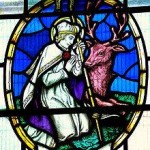St Cadoc gave his name (about 300 years after his death) to the village of Cadoxton which in those days was more important than the tiny village that was Barry.
The church is known as the old village church in Cadoxton. The original church fell into ruin – the reasons are not known – but the present church was built following the Norman invasion and the settling of Norman families in the area.
St Cadoc is important to the area (Cadoxton being named after him). His life seems to follow more of a ‘bad boy’ course than a saint but we cannot get away from the fact that he was sainted. The researcher of his life might conclude that this illustrates the power of good public relations – even if many years after his death. However, he may have been a bit of a bad boy but it is also clear that he did good. He one of those figures of power, a bit like the heroes of legend.
We are concerned with a period of history in Wales that seemed to be very much affected by magic, the clergy and the church generally with the period being dubbed ‘the age of saints’ by some. There is no doubt that Cadoc was one of the most important of the saints in South Wales.
Cadoc was born into a minor royal household and baptised Cadfael; his reputation began very early as it was claimed that before he was born he was responsible for strange lights shining in his parents’ house and the cellars were miraculously filled with food. With such a start to one’s life it is no wonder that myths build up. After his birth a holy well appeared for his baptism and afterwards it flowed with wine and milk.
Churches all over South Wales were dedicated to Cadoc, and he founded the great monastery of Llancarfan. He developed into be a great leader:
However, it appears that he had a disastrous impact on many of those close to him. He destroyed his parents’ marriage, persuading them to take vows of celibacy and eventually they were forced to move apart.
Cadoc’s father, Gwynllyw the Bearded, founded the monastery at Newport which bore his name, now St Woollos, and his mother Gwladus left for the hills above Gelli-gaer where she also founded a religious community. Their separation was a sad end for a marriage that began with the young couple eloping and escaping over the mountains. Such was the power that Cadoc seemed to wield. Cadoc was a persuasive and charismatic figure, and attracted devoted followers and students. He did however like to pick arguments and amongst those he is reputed to have disagreements with are St David, St Gildas, King Rhun of Gwynedd, King Arthur
One Lent he took two of his disciples from Llancarfan on a retreat to Flat Holm and then on to what is now Barry Island. When they reached Barry the students realised they had left Cadoc’s prayer book behind on Flat Holm. Cadoc sent them back to get it, in a storm, and then watched from the headland as their little ship foundered and they were drowned.
But the book was saved and the body of one of the students, Baruc, was found and he was buried on Nells Point. He became St Baruc giving the name to the village of Barry and having a church dedicated to him in what is now Friars Road, Barry Island. Unfortunately the church is a ruin and barely discernible as the site is so overgrown.
St Baruc’s feast day is the 27th September.
That of St Cadoc is the 25th September.

